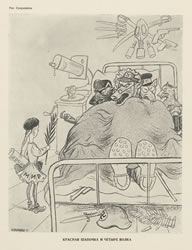
Text and arrangement by Charles N. Saenz
Russian translations by Matt Shindell
Additional assistance provided by the staff of the Mandeville Special Collections Library
Political satire is as old as organized society. It is not uncommon to find varying forms of pictorial graffiti on the walls of ruins the world over. For preliterate societies, images were a staple of communication, and served a necessity to circumvent the exchange of ideas by means of the written word. Amongst literate societies, the use of satirical devices developed in richness. The classical authors of Greek and Roman antiquity made frequent use of such methods in their writings, the tradition continuing well into the modern era with writers of all sorts.
Prior to the fifteenth century, the production of satirical images relied on the use of human copyists. With the invention of the printing press, the potential for the spread of these images widened. It was with the late nineteenth and early twentieth centuries that drawings in serialized form became a standard of the news industry, rapidly becoming a staple of daily periodicals. The use of political cartoons contributed to a news business where the subjective characterization of public figures often followed the political stance of the paper. In an increasingly visual society of this sort, images became part of the propaganda wars led by major political parties, trade unions, and other civil societies.
With the advent of the Spanish Second Republic (1931-1939) and Civil War (1936-1939), the dramatic expansion of the publishing industry in the realm of political propaganda proved a boon to the field of political cartoons and caricature. Unlike posters, these images were often printed in black on smaller sheets of paper known as broadsides. The broadsides themselves provided for the circulation of large quantities of material produced in quick and cheap manner. Their size allowed for both public and private use, which meant while some broadsides were posted to the walls of large squares and meeting places others were kept and often displayed by individuals. To cite the often quoted maxim, “a picture is worth a thousand words,” broadsides offered in one look what sometimes took political organizers whole speeches to convey.
Satirical imagery was used to offer biting commentary on a variety of issues. Hardly a novelty to the Spanish, the use of images as biting commentary requires special mention of the large number of prints completed by Francisco Goya in the late eighteenth century. Los Caprichos, as the prints are known, rendered a condemnation of many social, cultural, and political conventions of the era. Similarly, the broadsides included in this collection were intended to impart as much a condemnation of certain practices and social groups as to spur mobilization at the front and elsewhere.
The documents in "Lampooning the Right" date from the period following the proclamation of the Spanish Second Republic in 1931 to the end of the Civil War in 1939. Without exception, they promote the Republican cause. Though several of the images in the collection were created at the behest of domestic political organizations like the regional government of Catalonia (Generalitat de Catalunya), many were printed in Mexico City. Unfortunately, the origin of some images remains uncertain.
The materials included in this website were taken from the holdings of the Southworth Spanish Civil War Collection of the Mandeville Special Collections Library at the University of California, San Diego. This digital exhibition is meant to serve as a complement to other electronic exhibitions organized by the library and as a companion to the public and researchers interested to learn more regarding the use of diverse forms of media in one of the major episodes in the history of modern political propaganda.
The navigation above leads the viewer to several collections of material organized thematically. Each page includes a brief summation of relevant historical background and specialized information regarding the images on display. The images on this site were digitally scanned; originals are held in the Mandeville Special Collections Library.
 Contact Us
Contact Us